
Selecting an irrigation pump
Author: Bill Yiasoumi
Farmers can select from a wide range of pumps for irrigation purposes. Some applications have special pump requirements, but there are many common considerations in the selection of an appropriate pump. Some of these are:
- discharge and pressure (or head) required
- suction conditions
- frequency of operation
- reliability required
- source of power available
- cost per unit of power
- capital cost, depreciation and interest charges
- physical constraints (for example, must the pump fit in a limited space such as a borehole?)
- shelter available (for example, will an electric motor need waterproofing?)
- potential for corrosion and wear
- facilities for maintenance.
The best pump for you depends on the type of irrigation system you have. The irrigation system and how you operate it will determine the pump performance you require. Descriptions of pumps and their performance will help you to select a suitable pump for your situation.
Types of pumps
Pumps are classified in two main categories, based on how energy is given to the water:
- rotodynamic pumps (for example, centrifugal pumps, mixed flow pumps, mixed flow bore hole pumps and axial pumps)
- positive displacement pumps (for example, piston pumps, and helical-rotor pumps).
The principal requirement for pumping equipment used in commercial sprinkler irrigation is high efficiency against comparatively high pressures. This requirement usually limits pumps used for spray systems to rotodynamic pumps.
Centrifugal pumps are widely used in agriculture and are a good example of the rotodynamic pump group.
However, for small systems requiring pump discharges of less than 2 L/s (2 litres per second), positive displacement pumps can be used under certain conditions. In irrigation terms, a pumping rate of 2 L/s is a very low flow and would be applicable to nurseries with misting jets, vegetable growers using drip irrigation, and domestic irrigation situations.
The two pump categories should be looked at separately since the basic principle of operation of each is different.
Rotodynamic pumps
Rotodynamic pumps have a rotating impeller which gives energy to the water. The speed and size of the impeller determines the pressure and the rate of water flow out of the pump.
The two main types of rotodynamic pumps are the volute pump and the turbine pump.
Volute pumps are widely used in irrigation. They are of simple construction, the only moving parts being the impeller and shaft. The impeller is housed in a casing (volute).
The volute pump most often used for irrigation purposes is the (radial-flow) centrifugal pump. It can be installed with the pump shaft in the vertical or horizontal position. Its size is specified by the internal diameter at the discharge outlet.
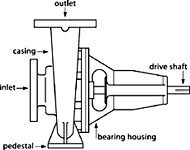
The advantages of the centrifugal pump include the following:
- It can be installed above the water surface.
- It can be mounted on skids for rapid removal from danger of floods.
- Not being submerged, it is less liable to corrosion, although most can operate submerged for short periods without damage.
- It can be installed as a portable unit and used at more than one pumping site.
- Where its use is applicable, it is easy and cheap to install.
- It is cheap to maintain.
Where large quantities of water have to be pumped against low heads, mixed-flow volute (MFV) pumps are used. At low heads it is possible to get higher efficiencies with MFV pumps than with radial-flow centrifugal pumps. Another advantage is that the power requirements (for a given speed) are approximately constant through the range of head and discharge.
Turbine pumps are mixed-flow and radial-flow (centrifugal) pumps which direct water to the discharge outlet with diffusion vanes. Axial-flow pumps, in which the impeller resembles a ship's screw, are generally classed with the turbines.
Since turbine pumps are most often used for pumping from bores, there is a limit on impeller diameter and the pressure which can be developed at a given speed. Volute pumps do not have this physical limitation. When high pressures are required from turbine pumps, extra impellers (stages) are added to the pump. Turbine pumps are driven by either a line-shaft or a submersible electric motor mounted below and close coupled to the pump.
The advantages of the turbine pump include:
- For bores and wells:
- It can be driven by an engine.
- It is less prone to damage by silt and sand in the water than the electro-submersible pump.
- It is easier to maintain than an electro-submersible unit.
- For dams, creeks and rivers:
- The prime mover can be mounted above flood level by extending the drive shaft.
- It can be used for supplies inaccessible to centrifugal pumps which would require too long a suction pipe.
- It can be used for high pressure conditions beyond the capacity of conventional centrifugal pumps.
- It can be used to pump silt or sand-laden water unsuitable for an electro-submersible pump.
Electro-submersible pumps are turbine pumps that are close-coupled to an electric motor. The motor and pump are in the one unit with the motor underneath keeping the unit submerged. The motor depends on the water pumped for cooling, and a failure of the water supply can result in serious damage to the unit. The pump is dimensioned for use in bores and is very long in comparison to its diameter.
The advantages of the electro-submersible pump are:
- It does not have a long drive shaft.
- It may be installed in a misaligned bore.
- It may be installed in rivers subject to flooding. As the pump has no above-ground working parts, the starting equipment, meter and transformer can be placed above flood level on a pole.
Jet pumps are single-stage centrifugal pumps fitted with a special assembly called an ejector. The ejector allows the pump to draw water from depths not possible with a conventional centrifugal pump. The disadvantage of jet pumps is their very poor efficiency and discharge when used in high pressure applications.
Positive displacement pumps
The positive displacement (or reciprocating pump) consists of a piston (or displacer) moving in a cylinder from which liquid enters or leaves through a valve arrangement. The positive displacement pump is a low volume, high head pump, and so is not used extensively in irrigation systems. Where these pumps are used, they are most commonly in constant flow systems like drip, spray or mist irrigation.
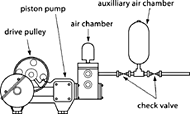
Piston pumps have a horizontal cylinder sealed at both ends with a piston inside. As the piston moves backwards and forwards, water is drawn in during the suction stroke and discharged during the compression stroke. The discharge pulsates because of this and needs to be smoothed out using an air chamber in the delivery line.
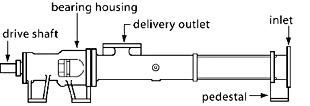
Helical rotor pumps are single screw pumps consisting of a rigid screw-like rotor rolling with a slight eccentric motion in a resilient internal rubber lining (stator). The rotor and stator engage so that a constant seal between the two is maintained. The diameter, pitch and eccentricity of the rotor control the pump's performance.
The characteristic curve (see below) for helical rotor pumps is very steep: small changes in flow result in large changes in pressure.
All positive displacement pumps require a pressure relief valve downstream of the pump to protect the mainline.
Variable speed pumps
Traditionally, electric motors have operated at a fixed speed. Variable speed technology allows pumps to operate at exactly the speed required for the pump duty, without the need for throttling the system. In long pipelines, using variable speed control can substantially reduce water-hammer effects.
Variable speed motors are more costly than fixed speed motors but they offer significant savings in power costs. Apart from these savings, many farmers are finding that variable speed drives provide the flexibility required for their range of irrigation demands.
These pumps are being installed as a single unit or as part of a multi-pump package (packaged pressure systems) combining variable and fixed speed pumps.
Packaged pressure systems (also called pressure-boosting systems) consist of two or more pumps operating in parallel. These systems combine variable speed and fixed speed pumps, and are used where a wide range of operating conditions is required. They give irrigators the flexibility to irrigate anything from a small poly house to several hectares of production.
The units are modular, and, provided there is an allowance for expansion, extra pumps can be added to cater for any planned farm development.
Characteristic curves
Pump manufacturers provide performance characteristics called pump characteristic curves. They are a graphical representation of the relationship between the variables involved in pumping:
- head
- discharge
- speed
- power
- cavitation susceptibility (limiting suction lift).
For centrifugal pumps, the curves simplify the selection process. They can be presented in either one of two ways:
- at a constant speed with a set of head/discharge curves with various impeller diameters (Figure 1)
- a set of head/discharge curves at varying speeds but with a constant impeller diameter (Figure 2)
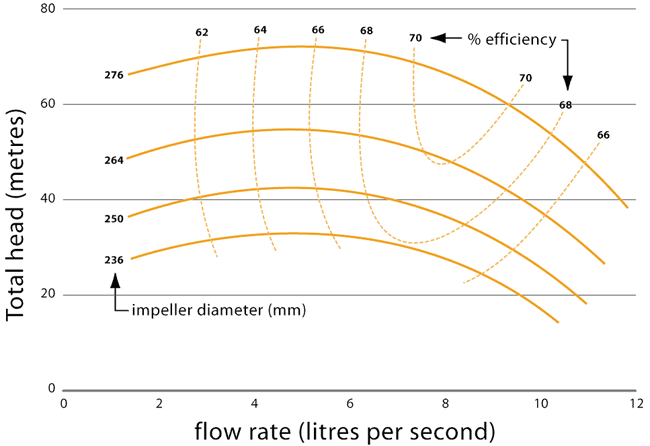
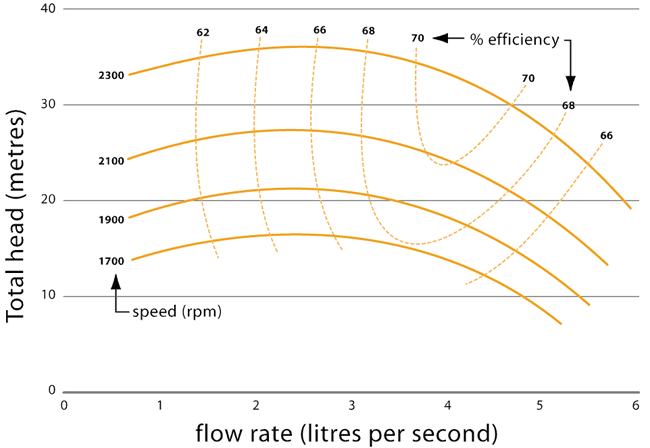
To obtain an operating point on the characteristic curve we must know the pump duty. Pump duty is the basis of pump selection, and is the performance required of the pump. It is expressed in terms of flow rate (or discharge) and the total head (pressure) required. For example, in the second performance curve, a flow rate of 4 L/s and a total head of 25 m requires the pump to be operated at 2100 rpm for an efficiency of about 70%.
Suction performance
Most problems with volute pumps can be traced to the suction system.
Water is non-cohesive and cannot be pulled. It is not lifted by a pump, but pushed by atmospheric pressure to the low pressure area created at the suction inlet of the pump. The suction `lift' a pump can handle is a function of pump design and atmospheric pressure.
Theoretically, the atmosphere at sea level will push water about 10 m up an evacuated column. This height is reduced by elevation, about 1.1 metres per 1000-metre increase in altitude. The actual suction lift must be less than this to allow for friction, pump design and pump wear.
Suction lifts are shown on some characteristic curves produced by pump manufacturers.
Cavitation
Cavitation is the formation and subsequent collapse of bubbles (cavities) of vapour in the water. The bubbles form when the liquid boils. Boiling can happen without heating, when the absolute pressure of the water is reduced to the point where vapour bubbles form.
The water carries these bubbles to regions of higher pressure in the pump where they suddenly collapse. If the bubbles collapse near a metal surface, then pitting of the surface will occur. Cavitation is accompanied by noise and vibration, and the vapour bubbles decrease the performance (the efficiency) of the pump.
To avoid the undesirable and costly effects of cavitation, do not site the pump so that it has to raise water more than the limit of suction lift set by the manufacturer.
Protection or control equipment
Controls for irrigation pumping equipment fall into two groups:
- prime mover (engine or motor) protection
- protection of the irrigation system.
A variety of pressure, temperature and water level sensing devices are available. They are usually fully automatic and are designed to override the manual control if anything happens which could damage the pumping unit or irrigation system.
1. Prime mover protection
Diesel engines running unattended should be protected against any failure of the pressure lubrication system, water cooling system or belt drive components, as applicable.
Electric motors are usually protected by sensing current rises or temperature rises, thus detecting electrical overloads.
Both types of prime mover should also be protected against overloads resulting from a change in delivery conditions. For example, a pipe failure with rotodynamic pump system will result in a large increase in power demand, beyond that which can safely be met by the prime mover.
2. Distribution system protection
Pipelines usually break because of too much pressure. If a pipe breaks, then there is a risk of pump damage: crop losses around the break are also likely. A pressure-sensing device to stop the pump avoids both of these possible outcomes.
Pipeline protection can also be achieved by monitoring the pump output and taking care in the manual operation of valves, that is, closing and opening them slowly.
Efficiency and cost
With the ever-rising cost of power and the need to use water effectively, the overall efficiency of a pumping system will continue to be of major importance to farmers.
The selection of a pump, prime mover and piping to provide the best operating efficiency for your system will result in lower power costs. Good design also results in a longer component life, further reducing operating costs through lower maintenance costs.
Good design and correct pump selection will also assist you to use your water effectively.
The first place to begin looking at improving efficiency is at the pump. As the pump is a major energy consumer, any improvement in its efficiency reduces the cost of operating the system. However, other factors should also be considered. Further savings may be found in improved pump operation and maintenance and by the selection of system components (such as pipe diameters, valves and fittings) which do not add excessive head losses.
Effect of wear and corrosion
A major factor in the loss of performance of pumps is due to the everyday wear and corrosion on internal parts of the pump. Wearing down the impeller vanes, for example, reduces the effective impeller diameter and results in a general loss of performance over the full range of the pump characteristic curve.
The three main types of physical deterioration are:
- abrasion
- corrosion
- cavitation.
The rate of deterioration depends on:
- material type
- water quality
- temperature
- mechanical design
- maintenance schedule
- suitability of pump for the duty
- cavitation susceptibility.
Troubleshooting
These diagrams can be used to help identify and remedy common operating problems in centrifugal pumps, the most commonly used irrigation pumps.
If the pump is noisy and vibrating:
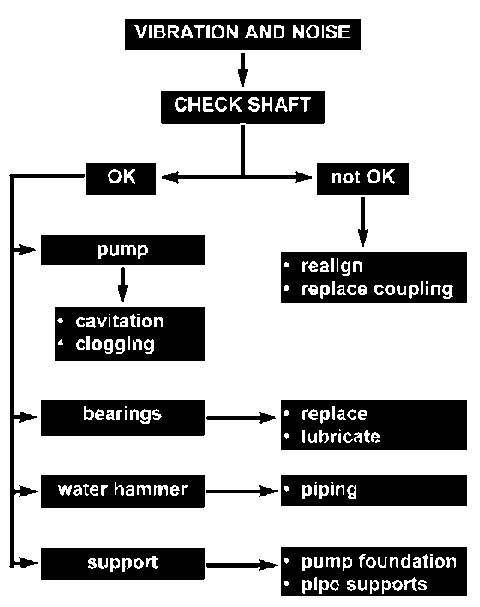
If the pump does not start:
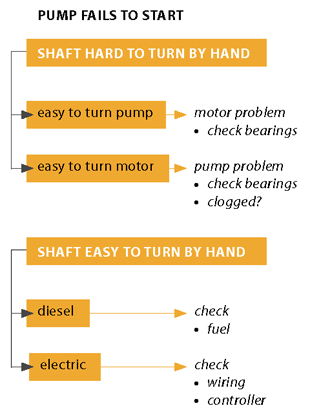
Table 1. Troubleshooting guide for centrifugal pumps
| Problem | Possible solution |
|---|---|
| No water |
|
| Not enough water |
|
| Low pressure |
|
| Too much power used |
|
| Pump works, then stops |
|
Pumping do's and don't's
Do:
- site the pump as close as possible to the water
- make sure suction and delivery pipes do not put a strain on the pump casing
- check that all pipe connections are tight
- use a strainer recommended by the pump manufacturer
- anchor the pump securely so that it doesn't move during operation
- work the pump within its limits
- provide ventilation for the motor or engine
- keep the pump and motor connection aligned
- make sure the pump is primed before starting
- keep the strainer clean
- service the pump regularly.
Don't:
- pump corrosive liquids
- operate the pump without water
- operate the pump if the discharge valve is closed
- operate the pump if the strainer is blocked
- operate the pump if it is vibrating excessively
- install the suction pipes so that air can build up in them
- forget to do regular maintenance.

